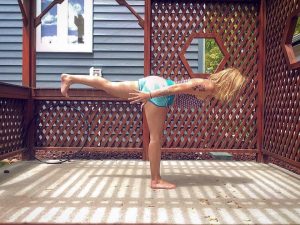
Incorporate mindfulness in to your personal training to make your job easier and the training more effective for your clients.
How often have you asked a client how an exercise is feeling, and they respond with something equivalent to “I’m not sure, okay I suppose?” Responses like these leave a trainer to rely on only their observational abilities and knowledge of anatomy and proper body mechanics, to be sure the client is safe.
Wouldn’t you love to improve your client’s mindfulness in the gym so that they are more involved and providing better feedback?
Here are three methods to help improve your client’s mindfulness and body awareness that are discussed in this article.
- Breath: Teach clients proper breathing patterns and help them when they forget
- Learn how to decipher discomfort and true pain
- Keep clients engaged by practicing balance and multi-planar exercises
Let’s dive in!
You don’t need to meditate to be Mindful
The fitness and gym industry is at a beautiful crossroads. The tendency for aesthetically based fitness goals are beginning to merge towards wellness and health related aspirations. Our society is starting to earnestly view exercise as a preventative and treatment method for many autoimmune and chronic diseases.
More and more we hear our clients saying they want to improve their longevity, extended their independence in later years, and feel good in their body. These are wonderful and rewarding goals for a trainer to help their client work towards. This is not to say I believe goals concerning body image and physical appearance to be ineligible. Every fitness and wellness goal has its place and value. However, it is heartening to see that exercise is being recognized for the host of health benefits it produces.

Obstacles personal trainers run into
Most client’s lack comprehensive body awareness. They struggle to decipher between the discomfort of exercise and contradictory or warning pain. There is a tendency be overwhelmed or put off by the body’s natural physiological responses to exercise, and becoming frustrated when they can’t quickly master a new workout.
What if the trainer created a more mindful approach? Teaching clients how to tune into their body, recognize and analyze their body’s responses, and know when they are approaching their physical limits, will help maintain successful and safe training sessions.
Start with the basics of breathing
What can be one of the first things that are lost during the performance of an exercise?
The breath! As a yoga instructor turned personal trainer, I can’t emphasize how important established breathing patterns are in exercise.
Proper breathing mechanics in all exercise will improve:
- Effectiveness of workout
- Maintaining correct form
- Concentration during execution
When the inhale and exhale are performed during the proper points of muscular contraction, the client is that much safer. Exhaling during the most force production keeps internal abdominal pressure down, discourages sharp spikes in blood pressure, and reduces stress on the body which ultimately makes the exercise easier to perform.
As almost all of you reading this are trainers, and already know the importance of breath. What is challenging is helping you client to breath. I see a lot of clients that do not like to breathe; at least this is what you would assume watching them exercise. The breaths are short, shallow and incomplete. On top of this, they are silent!
Steps to encourage better breathing
- For every exercise of every session cue when to inhale and when to exhale. It isn’t their profession to remember proper breathing patterns during exercise, they forget! They will appreciate your reminders
- In each session have the client practice measured breathing. During pre-determined exercises have them inhale and exhale for 2-3 counts, this means the movement occurring during the inhale and exhale will also be performed at this pace. This technique will not only improve breath control and depth but will also bring some progression into what might be a well-mastered exercise.
- Encourage an audible exhale. There is nothing wrong with making a little noise, in fact, it helps to release the building tension and exhaustion from the exercise. Your client might feel embarrassed, so exhale with them, turn up the music in the gym or move them to a less populated area.
Communicating perceptions of pain
The big bad “P” word of exercise. Ask almost anyone that avoids exercise why and they will respond “Because it hurts.”
In some ways these people are right, but they are using the wrong word to describe it to themselves. I am not trying to convince anyone that exercising will be an easy breezy experience. However, it is not true pain. Breaking bones, tearing ligaments and tendons is pain. Car wrecks and child birth are pain. Doing some jumping jacks and squats are not true pain. They are a discomfort, they are uncomfortable but not painful.
One of the best things you can do to encourage a more mindful gym experience is teach your clients to recognize the difference between the natural discomforts of exercise and warning pain.
How to differentiate between uncomfortable sensations
- If your client mentions pain during an exercise have her describe it. Is it sharp, hot, pinching, dull, aching, pulsing, pulling? Give her the vocabulary so they can begin to identify how they are feeling.
- Explain the biology behind the burning sensation she will experience during the execution of an exercise. She will be more willing to challenge herself if she understands this pain is safe and endurable
- Bring him back to his breath when he is experiencing the “burning” sensation. Cue him to measure his inhales and exhales and remained focus on safely completing his set.
- After his session ask him how he feels after completing it. Not just physically but mentally. Conclude the session with a mental check in on his accomplishments that day rather than him leaving feeling physically exhausted and beat down. Ending a training session this way will leave your clients’ last thoughts of the session on a positive and motivational note. Encouraging excitement to return, not dread.
Moving the perspective of exercise being painful to it being a rewarding physical challenge will bring countless benefits to your client’s training sessions. They will be more excited thus more motivated during their appointments, they will improve their mental strength and personal limits, and they will genuinely enjoy their exercise.
Help your clients pay more attention
Generally, a client is not responsible for designing their workouts, counting their reps and sets or what muscle group is being targeted. This is our job, which can often times lead to the client losing focus during a session. Some clients just want to get it done and over with, and mindlessly perform exercises when they are told.
Help your client create a better connection with their body by implementing exercises that are:
- Multi-planar
- Require balance
- Challenge core to maintain stability
- Has a patterned tempo
By sprinkling these throughout your client’s sessions you will see them engage more, feel more confident in their physical capabilities, and maintain consistent focus during their sessions.
On the mindful level, with improved balance automatically comes a more genuine connection with the body. Learning balance requires the client to “look” inwards. They must focus on how their body placement and muscles maintain a balance, which gives them a physical awareness that wasn’t present before. More balance means a greater understanding of how one’s body moves.
Now go make your gym a more engaged and wellful environment by passing on these mindful practices to all your clients and co-workers!
[info type=”facebook”]Which method did you find most helpful? Come tell other NFPT trainers on the Community Page to encourage mindfulness. If you’re not NFPT Certified, chat with NFPT here – we’d love to meet you![/info]
Alex has her A.S in Exercise Science and is a certified Personal Trainer with NFPT and NSCF. She recently traveled to India to gain her 200 hr yoga teacher certification where she studied the ancient practice at its origins. Alex has spent time teaching yoga in Spain while volunteering at a yoga retreat and is currently working at her local college instructing two fitness courses. Alex wants to share with her clients and students the mental, physical and emotionally healing qualities of exercise and movement. She believes everyone should have a healthy relationship with their bodies and strives to thread that concept throughout her career.

